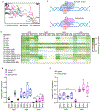Exploring and engineering PAM-diverse Streptococci Cas9 for PAM-directed bifunctional and titratable gene control in bacteria
- PMID: 36404524
- PMCID: PMC10947553
- DOI: 10.1016/j.ymben.2022.10.005
Exploring and engineering PAM-diverse Streptococci Cas9 for PAM-directed bifunctional and titratable gene control in bacteria
Abstract
The RNA-guided Cas9s serve as powerful tools for programmable gene editing and regulation; their targeting scopes and efficacies, however, are always constrained by the PAM sequence stringency. Most Streptococci Cas9s, including the prototype SpCas9 from S. pyogenes, specifically recognize a canonical NGG PAM via a conserved RxR PAM-binding motif within the PAM-interaction (PI) domain. Here, SpCas9-based mining unveils three distinct and rarely presented PAM-binding motifs (QxxxR, QxQ and RxQ) among Streptococci Cas9 orthologs. With the catalytically-dead QxxxR-containing SedCas9 from S. equinus, we dissect its NAG PAM specificity and elucidate its underlying recognition mechanism via computational prediction and mutagenesis analysis. Replacing the SedCas9 PI domain with alternate PAM-binding motifs rewires its PAM specificity to NGG or NAA. Moreover, a semi-rational design with minimal mutation creates a SedCas9-NQ variant showing robust activity towards expanded NNG and NAA PAMs, based upon which we engineered a compact ω-SedCas9-NQ transcriptional regulator for PAM-directed bifunctional and titratable gene control. The ω-SedCas9-NQ mediated metabolic reprogramming of endogenous genes in Escherichia coli affords a 2.6-fold increase of 4-hydroxycoumarin production. This work reveals new Cas9 scaffolds with distinct PAM-binding motifs for PAM relaxation and creates a new PAM-diverse Cas9 variant for versatile gene control in bacteria.
Keywords: 4-hydroxycoumarin; CRISPR interference and activation; Cas9 engineering; Gene control; Metabolic engineering.
Copyright © 2022 International Metabolic Engineering Society. Published by Elsevier Inc. All rights reserved.
Conflict of interest statement
Declaration of competing interest The authors declare that they have no competing interests.
Figures





Similar articles
-
Engineering a Streptococcus Cas9 Ortholog with an RxQ PAM-Binding Motif for PAM-Free Gene Control in Bacteria.ACS Synth Biol. 2023 Sep 15;12(9):2764-2772. doi: 10.1021/acssynbio.3c00366. Epub 2023 Aug 29. ACS Synth Biol. 2023. PMID: 37643152 Free PMC article.
-
Molecular basis for the PAM expansion and fidelity enhancement of an evolved Cas9 nuclease.PLoS Biol. 2019 Oct 11;17(10):e3000496. doi: 10.1371/journal.pbio.3000496. eCollection 2019 Oct. PLoS Biol. 2019. PMID: 31603896 Free PMC article.
-
Developing Heritable Mutations in Arabidopsis thaliana Using a Modified CRISPR/Cas9 Toolkit Comprising PAM-Altered Cas9 Variants and gRNAs.Plant Cell Physiol. 2019 Oct 1;60(10):2255-2262. doi: 10.1093/pcp/pcz118. Plant Cell Physiol. 2019. PMID: 31198958
-
CRISPR technologies and the search for the PAM-free nuclease.Nat Commun. 2021 Jan 22;12(1):555. doi: 10.1038/s41467-020-20633-y. Nat Commun. 2021. PMID: 33483498 Free PMC article. Review.
-
Recent Updates of the CRISPR/Cas9 Genome Editing System: Novel Approaches to Regulate Its Spatiotemporal Control by Genetic and Physicochemical Strategies.Int J Nanomedicine. 2024 Jun 6;19:5335-5363. doi: 10.2147/IJN.S455574. eCollection 2024. Int J Nanomedicine. 2024. PMID: 38859956 Free PMC article. Review.
Cited by
-
Off-target interactions in the CRISPR-Cas9 Machinery: mechanisms and outcomes.Biochem Biophys Rep. 2025 Jul 5;43:102134. doi: 10.1016/j.bbrep.2025.102134. eCollection 2025 Sep. Biochem Biophys Rep. 2025. PMID: 40688512 Free PMC article. Review.
-
The expanded CRISPR toolbox for constructing microbial cell factories.Trends Biotechnol. 2024 Jan;42(1):104-118. doi: 10.1016/j.tibtech.2023.06.012. Epub 2023 Jul 26. Trends Biotechnol. 2024. PMID: 37500408 Free PMC article. Review.
-
Current Updates of CRISPR/Cas System and Anti-CRISPR Proteins: Innovative Applications to Improve the Genome Editing Strategies.Int J Nanomedicine. 2024 Oct 9;19:10185-10212. doi: 10.2147/IJN.S479068. eCollection 2024. Int J Nanomedicine. 2024. PMID: 39399829 Free PMC article. Review.
-
Engineering a Streptococcus Cas9 Ortholog with an RxQ PAM-Binding Motif for PAM-Free Gene Control in Bacteria.ACS Synth Biol. 2023 Sep 15;12(9):2764-2772. doi: 10.1021/acssynbio.3c00366. Epub 2023 Aug 29. ACS Synth Biol. 2023. PMID: 37643152 Free PMC article.
-
Utilizing Target Sequences with Multiple Flanking Protospacer Adjacent Motif (PAM) Sites Reduces Off-Target Effects of the Cas9 Enzyme in Pineapple.Genes (Basel). 2025 Feb 13;16(2):217. doi: 10.3390/genes16020217. Genes (Basel). 2025. PMID: 40004545 Free PMC article.
References
-
- Anzalone AV, Koblan LW, Liu DR, 2020. Genome editing with CRISPR–Cas nucleases, base editors, transposases and prime editors. Nat. Biotechnol 38, 824–844. - PubMed
-
- Barrangou R, Fremaux C, Deveau H, Richards M, Boyaval P, Moineau S, Romero DA, Horvath P, 2007. CRISPR provides acquired resistance against viruses in prokaryotes. Science. 315, 1709–1712. - PubMed
Publication types
MeSH terms
Substances
Grants and funding
LinkOut - more resources
Full Text Sources
Molecular Biology Databases
Research Materials
Miscellaneous

